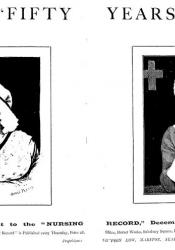The Rise of the Victorian Working Lady
The increasing demographic imbalance between men and women in Britain in the nineteenth century forced many women and girls from the middle classes to seek employment to maintain themselves because, in the words of one commentator, “there were not enough husbands to go round.” Working for pay, however, was considered déclassé and the employments that emerged as two of the most popular for middle-class women, nursing and typewriting, had to overcome cultural resistance.
The major constraints on efforts to find suitable work for middle-class women were the social and cultural restrictions inherent in Victorian notions of respectability and femininity. But, given the economic and demographic realities of the time, women, as the English Woman’s Journal asserted in 1858, were going to have to work, and “work as they . . . [had] not done yet” (364). Articles in the media about women and work advocated a broad range of possibilities, from the entirely genteel, such as china painting, to the physically and organizationally demanding, such as running a dairy farm. Many of these suggestions were impractical, either because they would not provide a sufficient income or because they required specialized knowledge and other resources that most young women would not have (Young, “Professionalism” 201.). Ultimately, the three areas of work that had the most promise for young middle-class women in the second half of the nineteenth century were teaching, nursing, and typewriting—all jobs that were the principal areas of work for respectable young women throughout the twentieth century. All these areas of work were expanding in the nineteenth century, but only teaching carried with it the aura of both femininity and propriety essential to respectable employment for middle-class women. Teaching in schools was a logical extension of governessing, and while the opening up of board schools in the 1870s did lower the prestige of teaching to some extent, it also opened up many more opportunities for women.

